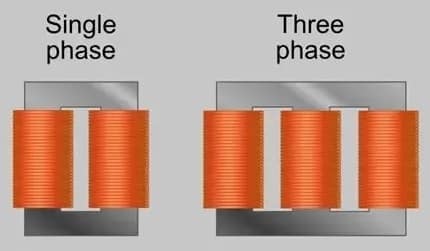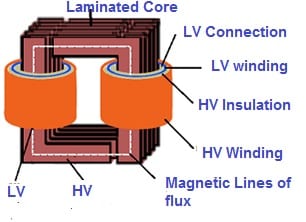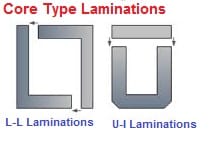Core type transformer has a magnetic core, and the primary and the secondary winding around the core. The core-type transformer can be categorized according to the shape of the magnetic core. Based on core construction, we classify the transformer as core and shell types.
In a core-type transformer, the winding encircles the core, whereas in a shell-type transformer, the core encircles the winding. The winding encircles the core of a transformer. The Single-phase transformer has two limbs, and the three-phase transformer has three limbs.
Types of Core-Type Transformers
There are two types of core-type transformers.
- Single Phase Transformer
- Three Phase Transformer
The single-phase transformer accepts single-phase AC voltage and outputs single-phase AC voltage according to the turns ratio of the transformer. A three-phase transformer converts three-phase AC voltage into three-phase AC voltage according to turns ratio. A three-phase transformer is most suitable for transmission and distribution purposes.

The core of a single-phase transformer has a single window and two limbs.

Both HV and LV winding are wrapped around both limbs. The LV winding is placed near the core, and the HV winding is placed after the LV on the same limb. This way, the transformer size becomes compact due to less insulation requirement. The transformer cost is reduced by placing the LV and HV winding on the same limb.
The main disadvantage of a core-type transformer is that all the flux produced in the primary does not link to the secondary, and some parts of the flux link to other parts of the transformer. Thus, the leakage flux in the core-type transformer is higher than the flux utilization in the shell-type transformer.
However, the core type arrangement is most suitable for the large rating transformer because of more accessible winding during maintenance. If there is a fault in the inner winding, we can easily remove the inner winding after removing the outer winding.
Read More: Shell Type Transformer- Its construction & Working
Core & Winding Construction of Core Type Transformer
There are different types of lamination suitable for the core-type transformer.

L-L and U-I stamping lamination, when connected, form the required core shape.
The designer selects the transformer core shapes according to the transformer rating. In a small rating transformer, the winding is square or rectangular; therefore, the square or rectangular cross-section core is suitable for the core-type transformer.
The small rating transformer has lower current-carrying capacity conductors, and it is easy to wrap the conductors in a square or rectangular shape. The square or rectangular core is economical for the small rating transformer.
For large rating transformers, the thick winding conductor is suitable for carrying more current. It isn’t easy to bend the thick conductor in a square or a rectangular shape. The round cylindrical-shaped winding is the best choice for the large rating transformer because of the optimized use of copper conductors.
However, the space between the winding and core is unused when the round cylindrical-shaped winding on a square cross-sectional core limb is used. The stepped cross-sectional core is used to reduce this unused space. The lamination of different shapes is staged to form a nearly circular cross-sectional core. The cross-section of the core may be one-stepped, two-stepped, or multi-stepped.
Application of Core Type Transformer
These transformers are best suited for high-voltage applications like power transformers, distribution transformers, and auto-transformers. The high voltage transformer works on high flux density. The thicker core used for the transformer causes lower core loss.
Also, a high-voltage transformer requires more amount of insulation. It is easier to put insulation in a core-type transformer. The low voltage winding also provides the insulation between high voltage winding and core. We use this type of transformer to step up the low voltage to high voltage and to step down the high voltage to low voltage.
Advantages and Disadvantages
The pros and cons of the core type of transformer are as follows:
Pros
- Robust – The symmetrical core protects the cylindrical-shaped winding. The core and winding are not affected by vibrations caused during transformer charging.
- Low Iron Loss – The lamination stacking in the core reduces the iron loss.
- Suitable for High-Frequency applications- It has low eddy current loss. Therefore, a core-type transformer is ideal for high-frequency applications.
Cons
- Not suitable for outdoor use- External environmental factors affect the internal parts of the transformer. Therefore, a core-type transformer is not suitable for outdoor applications compared to a dry-type transformer.
- Noisy- It produces an audible noise due to magnetostriction force in the core.